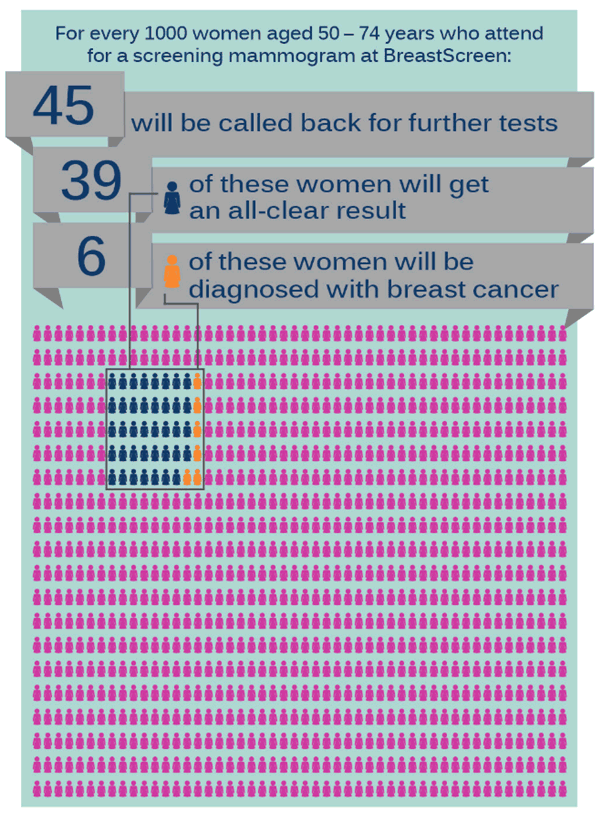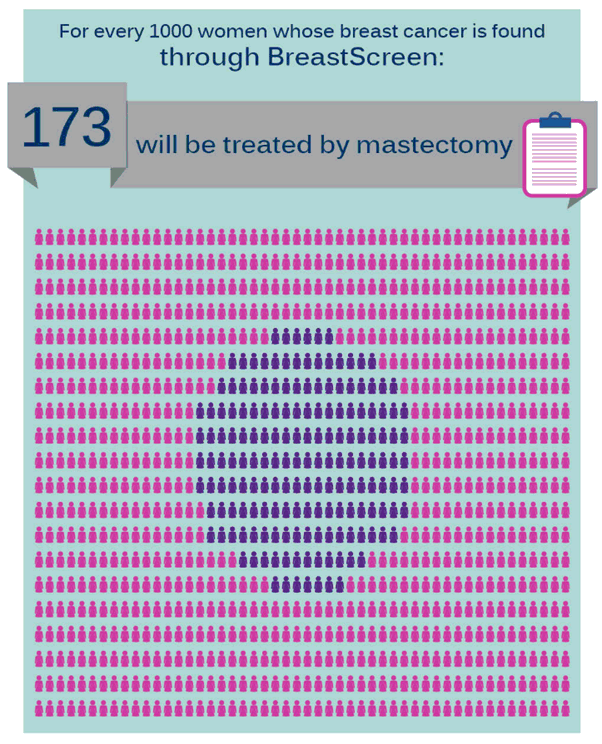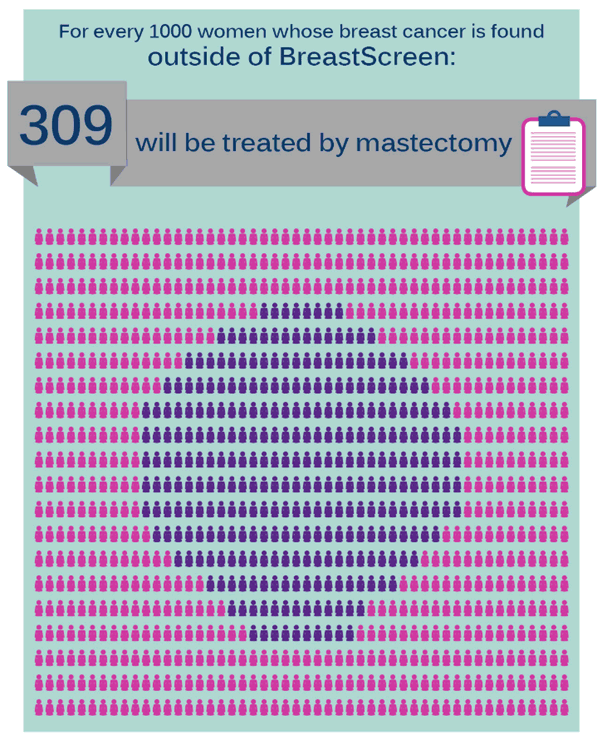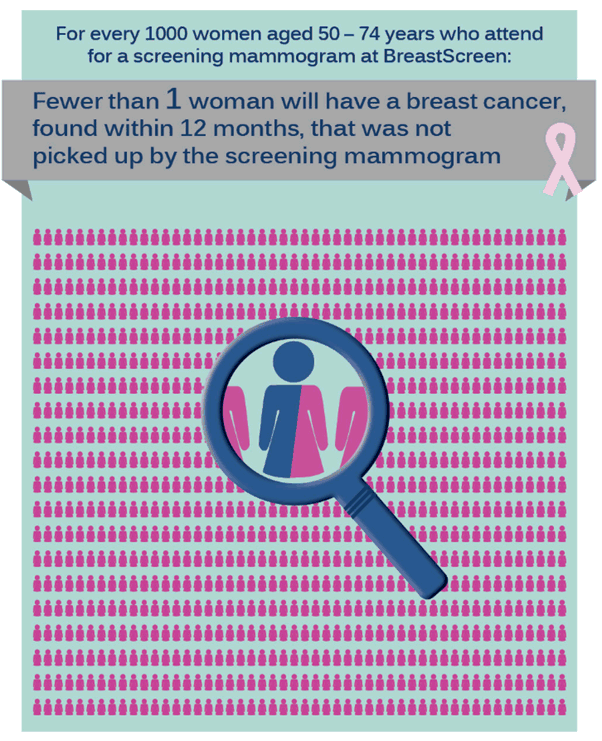Benefits and harms
Screening mammograms are used to find breast cancers early, often before they can be felt. Earlier detection, when the cancer is small and confined to the breast provides the best chance of effective treatment.
It is important women have information to make informed decisions about whether or not to have a screening mammogram. Weighing up the potential benefits and harms will help you decide whether a breast screen is right for you and whether or not you take part in the BreastScreen Australia Program.
For every 1000 women aged 50 – 74 years who attend for a screening mammogram at BreastScreen, 45 will be called back for further tests, 39 of these women will get the all-clear result, 6 of these women will be diagnosed with breast cancer: (Ref. BreastScreen Australia)

What are the benefits?
Preventing deaths from breast cancer in women aged 50 to 74 years
Less likely to have a mastectomy
Women who have breast cancers detected by screening are less likely to have a mastectomy (have their breast removed) than women who do not screen and detect their cancer when it presents as a lump or other clinical symptom.
If breast cancer is detected early, there are more treatment options. This is because breast cancer can be treated more effectively when it is still small and has not spread outside the breast to other parts of the body.
For every 1000 women whose breast cancer is found through BreastScreen, 173 will be treated by mastectomy. (Ref. BreastScreen Australia)

For every 1000 women whose breast cancer is outside BreastScreen, 309 will be treated by mastectomy. (Ref. BreastScreen Australia)

Reassurance
The majority of women will be reassured that their breast screen results showed 'no evidence of breast cancer'.
The reduction in breast cancer deaths in women aged 50 to 74 years substantially outweighs the risk of radiation induced cancer, for women participating in the program.
The number of deaths prevented is at least 100 times greater than those potentially caused by radiation from mammographic screening1.
Further information about screening mammograms and their radiation risks available here.
What are the harms?
A moderate number of women will find the examination painful.
Compression of the breast during mammography may cause discomfort and pain for some women. Compression of the breasts only lasts for a few of seconds for each mammogram. Women who have painful breasts are advised to take a mild analgesic such as Panadol prior to their mammogram and to book at the time of month when they experience the least breast pain.
Adverse psychological effects
Having a screening mammogram can increase anxiety about breast problems in some women. This can occur at different stages of the screening process – on receiving the invitation letter, attendance for a screening mammogram and the time period until women receive their results letter and/or complete screening. Attending an assessment clinic for further tests can be a particularly stressful and anxious time for those women recalled after an abnormal mammogram.
Finding and treating breast cancers that may not have become life threatening (overdiagnosis).
About 10% of invasive breast cancers found through screening may not become life-threatening. At this time, it is not possible to tell exactly which breast cancers may become clinically important in a woman’s life time and which cancers may not.
Further tests done but breast cancer is not found (false positive).
Some women will be asked to have more tests, including needle biopsies to investigate a mammographically detected abnormality that is not a cancer. This may include surgery on a small number of these women. For most women, the results of a recall to assessment will be normal.
Breast cancer is present but not found (known as an Interval Cancer).
Screening mammograms are the best way of finding breast cancers early, but they are not 100% accurate. A small number of breast cancers may not be visible on the mammogram at the time of screening.
The medical evidence is that women who develop a symptomatic breast cancer within 2 years of having a normal screening mammogram have the same prognosis and clinical outcomes as women who did not participate in the screening program and who develop a symptomatic breast cancer.

For every 1000 women aged 50 – 74 years who attend for a screening mammogram at BreastScreen, fewer than 1 woman will have breast cancer found within 12 months, that was not picked up by the screening mammogram: (Ref. BreastScreen Australia)
References
1. Advisory Group on Ionising Radiation. Risk of solid cancers following radiation exposure: estimates for the UK population. London: Health Protection Agency, 2011
All infographics courtesy of BreastScreen Australia.
Book online or phone 13 20 50
When making your appointment, please let us know if you:
- have breast implants
- require an interpreter
- use a wheelchair.
These things may make your appointment a little longer.
If you need an interpreter, please call the Translating and Interpreting Service (TIS) first on 13 14 50 and ask to be connected to the BreastScreen WA call centre on 13 20 50.
NOTE:
Wheelchair access is available at all BreastScreen WA services.
Appointments are available 7:30am-5:45pm on weekdays and 8:15am-11:30am on Saturdays at most BreastScreen WA clinics.
Get to know your breasts and what is normal for you. Look in the mirror at your breasts and feel your breasts from time to time.
If you notice any unusual changes in your breasts such as lumps, nipple discharge, or persistent new breast pain, even if your last screening mammogram was normal, please see your GP promptly.
Ask your GP about breast health at your next check-up.
Use our contact form or call BreastScreen WA on:
13 20 50 for appointments
9323 6700 for information

